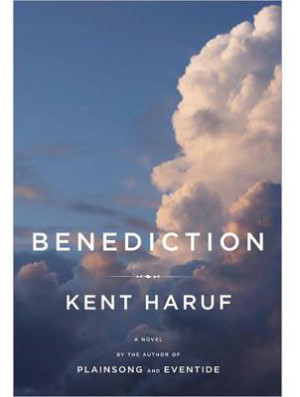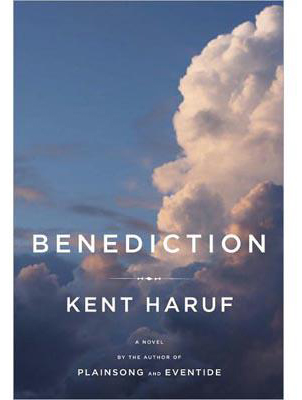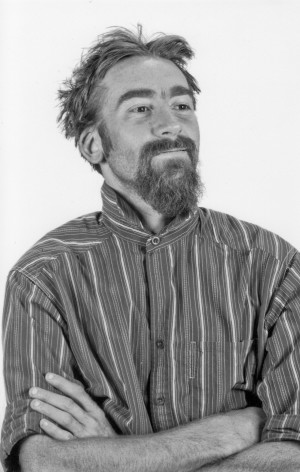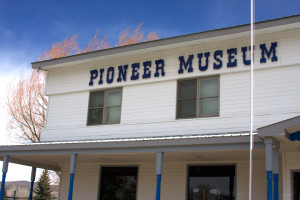Benediction By Kent Haruf
Alfred A Knopf, 2013
ISBN: 978-0-307-95988-1
$25.95, 258pp.
Reviewed by Eduardo Rey Brummel
With the 1984 publication of his first novel, The Ties That Bind, Kent Haruf introduced Holt, Colorado to the rest of the world. Haruf’s fifth novel, Benediction, arrived this past February – its initial paragraphs placing the main character into the trouble that will be the story:
Go on ahead, Dad Lewis said, say it.
I’m afraid I don’t have very good news for you, the doctor said.
When they went back downstairs to the parking lot it was late in the afternoon.
You drive, Dad said. … I just want to look out at this country. I won’t be coming out here again.
 Dad becomes increasingly bed-bound, and with little else to do begins reminiscing and reflecting, returning “out here” in his mind. As in anyone’s life, there have been moments of rightness, moments when his efforts have grievously gone afoul. And as is often the case with successful businessmen, Dad has not had much success on the home front. There’s something approaching estrangement from his daughter; and his son has disappeared, only rumored sightings remaining.
Dad becomes increasingly bed-bound, and with little else to do begins reminiscing and reflecting, returning “out here” in his mind. As in anyone’s life, there have been moments of rightness, moments when his efforts have grievously gone afoul. And as is often the case with successful businessmen, Dad has not had much success on the home front. There’s something approaching estrangement from his daughter; and his son has disappeared, only rumored sightings remaining.
Dad has his own history of estranging himself from both the ties that bind and where he once belonged. As he lays dying he is visited by his past, and is given a few opportunities to make things more right, if not totally so. He is also visited by his future. His daughter, Lorraine, takes leave from her job in order to stay as long as needed. Eight-year-old Alice, who’s now living next door with her grandmother due to her mother’s recent death to breast cancer, begins her visiting.
Roughly three-quarters into the novel, a middle-aged daughter and her mother are talking to a local minister. The daughter states, “All life is moving through some kind of unhappiness, isn’t it.” Her mother responds, “But there’s some good too. I insist on that.” In an earlier scene, Alice is riding her bicycle:
The light had gone out of the sky by now and the street lamps had come on and she rode, going back and forth, from pool of light to pool of light.
Haruf’s writing is reminiscent of the subtle, spare terrain of this novel’s setting. I suspect he regards his readers as being intelligent and capable enough to flesh out the conversations and scenes without any authorial handholding. It’s a quite visceral way to engage them. Of making the story matter to them. Of making it theirs.
When interviewed by Jim Nashold, in the spring 2002 issue of Glimmer Train, Haruf said of Colorado’s northeastern corner, “It’s a part of the country and part of the world which I call home, and which I have an emotional and almost holy response to when I re-enter it. It’s not pretty, but in my view it’s beautiful and you have to know how to look at it. … There’s plenty to see. It sort of teaches you to slow down. Teaches you to pay attention.”
It is this reviewer’s hope this novel isn’t Haruf’s benediction, and that there will be at least a postlude.
Colorado Women: A History By Gail M. Beaton
University Press of Colorado, 2012
ISBN 987-1-607-195-8 (cloth); ISBN 978-1-60732-207-8 (ebook)
380 pages, $34.95
Reviewed by Virginia McConnell Simmons
Since the 1970s, the output of popular and academic publications about the role of women in the West has been a growing field. Some products will be destined for musty library bookshelves, and some will be welcome on the nightstands of tired readers. With Colorado Women: A History by Gail M. Beaton, late-night readers may simply give up and turn off the light in puzzlement, while serious historians may throw up their hands in dismay. Yet, occasionally, a book like Beaton’s contains too much useful information to be dismissed.
As a reviewer, I did read the book from front to back and then decided, too late, that the best way to tackle it would have been at the back, with the index. It contains references to most of the text’s information, and the index is nearly the only way to locate much of it. In any case, beware of Chapter 2, which contains an excessive number of conspicuous errors and omissions.
Readers of the text will find that the author’s attention span leaps disconcertingly from biographical accounts to topical themes to even statistical data. With no explanation, an individual’s story may be broken up into different parts of a chapter or even into different chapters, and some of the information therein is repeated. Some sections contain totally unrelated paragraphs, apparently because there was no place else to put them. Organization be damned!
In addition to the organizational problems, early Colorado history clearly is not Beaton’s forte, as it appears that she has read few of the books listed in the back matter under “further reading.” Still, the endnotes reveal that she has been an indefatigable collector of tidbits, trivia and biographical information about Colorado’s females, past and present, famous, influential or largely unknown, but still I enjoyed learning these things about them and their experiences. Her writing gains strength in the modern era, when the author’s personal enthusiasms become apparent. Subjects such as politics, population statistics, employment, race, gender issues and women’s sports receive welcome attention that is often missing from literature about women. This volume is also noteworthy for its excellent selection of 52 photographs, illustrating women’s activities in each period of Colorado’s history.
Gail Beaton has been a teacher in public schools and community colleges in Denver. The book’s foreword reveals that she has also run in the Boston Marathon, where, one hopes, the route was clearly marked.




